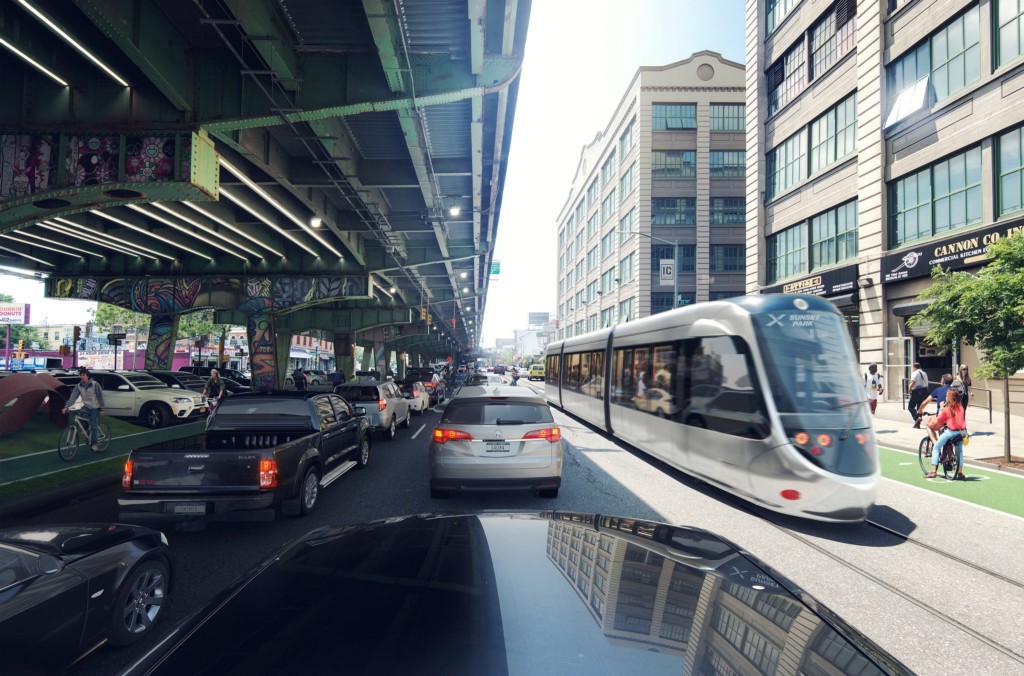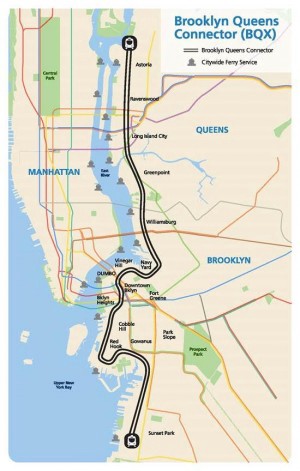Streetcar to Nowhere

A key point of the sixteen-mile Brooklyn-Queens Connector streetcar line proposed by New York City Mayor Bill De Blasio is that it would “generate over $25 billion of economic impact” and bring “quality transit” for “all those people and jobs” in thirteen neighborhoods along the waterfront from Sunset Park to Astoria.

The mayor has stressed that, despite the need for better transit options in more marginalized neighborhoods deeper in Brooklyn and Queens, and the touch-too-emphatic support from private concerns which stand to profit immensely from the $2.5 billion project, it would not solely benefit the people who can afford to live along the luxuriously developed waterfront now and over the next few short, glorious decades left before much of the city is underwater. In particular, De Blasio and his administration have pointed to the forty thousand tenants of New York City Housing Authority developments who would, streetcar supporters say, be served by the line — roughly ten percent of the total number of people who live by the waterfront — implying an easier commute for those people to get to work or to get groceries or to do any of the other things that are harder to do when one lives in a relative transit desert. Sounds great!
3. Project will NOT provide connections to L, J/Z, N/Q (in Astoria), or F (Smith/9th)
— Yonah Freemark (@yfreemark) February 16, 2016
But, while De Blasio is promising that the streetcar line will “connect” to ten ferry landings, fifteen subway routes, and thirty-odd bus lines, it’s unclear how well it will integrate with the existing MTA system; it will, at a minimum, require a separate fare card that is merely promised to cost the same per ride. (What precisely happens with respect to any possible integration between the streetcar and the subways or buses, like free transfers, is up to the MTA, which is controlled by the state, which is to say Andrew Cuomo, who hates Bill De Blasio and anything he does to try to end run him, like having the city build its own streetcar network outside of the purview of the MTA.) The streetcar will also apparently not connect riders to at least four vital subway lines. This will make it harder for riders to commute into Manhattan, where there are still very many jobs, even if it isn’t home to the city’s favored new “innovation clusters,” like the Navy Yard, which has seen hundreds of millions dollars in new residential and commercial development, including a $380 million site anchored by WeWork, despite being essentially cut off from public transit. Oh, and if the streetcar doesn’t fully integrate with existing subway and bus transit, it stands to reason that it would also make it difficult for people in other parts of Brooklyn to reach this corridor, shutting them out from “where the present and the future of our city are happening,” to cop several lines from the mayor’s latest press release. But who knows? It’s entirely uncertain.
What is for certain though, is that the streetcar, which will serve fifty thousand people per day, will make it easier for residents of Williamsburg to reach Andrew Tarlow restaurants located in other, more distant Brooklyn neighborhoods; for people paying thousands of dollars per month to live in the tallest buildings in Brooklyn to reach the more picturesque waterfront views of Red Hook; for Brooklyn Heights families to check out the food court in Industry City; for Time workers to get to the office from Long Island City; and of course for residents of streetcar supporter Two Trees Management’s properties clustered in and around DUMBO to easily get to the rest of theme park Brooklyn with ease.
This is good enough for the Times, which seems quite taken with this project, having written around a half-dozen pieces since its announcement:
Perhaps the streetcar line would not be in perfect economic equilibrium, but it would make it possible for more people to live along the waterfront. Mass transit works like irrigation for skyscrapers and housing.
This is more or less De Blasio’s pitch for building it: The streetcar would be free because it would generate $4 billion in increased property taxes, both from new construction and increased property values spurred by the line, easily covering the $2.5 billion cost of building it. (And… maybe that’s not incorrect.)
But one might still come back to the basic question of who, by and large, will benefit from being able to live and work in whatever is built cozily snuggled up against the waterfront and the streetcar line — both amenities desired by the tasteful and the wealthy, the primary customer for luxury condos, which are the predominant form of new residential construction in this city. Of course, there’s always the hundreds of people whose applications for the affordable housing that real estate developers bake into their luxury developments for tax credits get plucked from the pile of thousands. It’ll probably be good for them, too.
